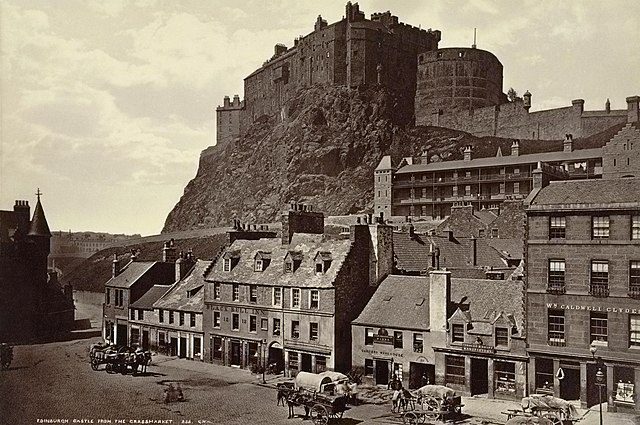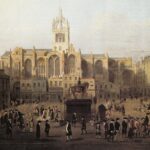
Edinburgh Castle stands as a symbol of Scotland’s rich history and architectural prowess. This iconic fortress dominates the skyline of Edinburgh, perched atop Castle Rock, an extinct volcanic hill. Edinburgh Castle is not only a major tourist attraction but also a profound reminder of Scotland’s past. This article will explore the fascinating history, architectural features, and cultural significance of Edinburgh Castle, a true architectural gem in the heart of Scotland.
The Historical Significance of Edinburgh Castle
Edinburgh Castle’s history dates back to at least the 12th century, making it one of the oldest fortified places in Europe. It has witnessed countless battles and sieges, serving as a royal residence and military stronghold. Its strategic location on Castle Rock offered a natural defense, making it a coveted site for rulers and invaders alike. The castle has played a central role in Scotland’s history, shaping the nation’s identity and heritage.
Throughout the centuries, Edinburgh Castle has been the backdrop for numerous historical events. It was the residence of Scottish monarchs, including Mary, Queen of Scots, who gave birth to King James VI within its walls. The castle’s significance as a royal residence highlights its importance in Scotland’s political and cultural history. Its role in shaping the monarchy’s legacy is evident in the many royal ceremonies and events held within its walls.
The castle’s military history is equally rich, having served as a key fortress during times of conflict. Edinburgh Castle withstood numerous sieges, including the famous Lang Siege of 1571-1573, when it was held by supporters of Mary, Queen of Scots. Its defenses were continually updated to adapt to changing military technologies and strategies. The castle’s ability to withstand these challenges underscores its strategic importance and enduring resilience.
Edinburgh Castle’s historical significance extends beyond its military and royal associations. It has also been a center of culture and learning, hosting events and gatherings that shaped Scotland’s intellectual landscape. The castle has been a site of education and inspiration, contributing to the development of Scottish culture and identity. Its legacy as a place of knowledge and enlightenment continues to this day, attracting scholars and visitors from around the world.
Architectural Features
Edinburgh Castle’s architecture is a testament to its rich history and the evolution of defensive structures over the centuries. The castle’s design reflects the changing needs and technologies of warfare, showcasing a blend of medieval and modern elements. Its imposing stone walls and battlements are characteristic of medieval fortifications, designed to withstand sieges and protect against invaders. These defensive features are a reminder of the castle’s strategic importance and its role in Scotland’s military history.
One of the most striking features of Edinburgh Castle is the Crown Square, which forms the heart of the castle complex. This area is home to some of the castle’s most important buildings, including the Great Hall and the Royal Palace. The Great Hall, built in the early 16th century, is a magnificent example of medieval architecture, with its high wooden ceiling and grand fireplace. It served as a venue for royal banquets and gatherings, reflecting the castle’s status as a royal residence.
The Royal Palace within Crown Square is another architectural gem, showcasing the opulence and grandeur of the Scottish monarchy. The palace’s interiors are adorned with intricate carvings and decorations, offering a glimpse into the lavish lifestyle of Scotland’s rulers. The Palace is home to the Honours of Scotland, also known as the Scottish Crown Jewels, which include the Crown, Sceptre, and Sword of State. These treasures are a symbol of Scotland’s royal heritage and are displayed in a specially designed vault within the palace.
St. Margaret’s Chapel is the oldest surviving building within Edinburgh Castle, dating back to the 12th century. This small chapel, dedicated to Queen Margaret, is a beautiful example of Romanesque architecture, with its simple yet elegant design. The chapel’s historical significance lies in its connection to Queen Margaret, a revered figure in Scottish history known for her piety and charitable works. St. Margaret’s Chapel is a place of reflection and remembrance, offering visitors a glimpse into Scotland’s medieval past.
Technological Innovations
While Edinburgh Castle’s architecture is steeped in history, it has also embraced technological advancements to enhance its visitor experience. The castle has incorporated modern technologies to preserve its historic structures and improve accessibility for visitors. These innovations ensure that Edinburgh Castle remains a relevant and engaging destination for tourists and historians alike.
One of the key technological innovations at Edinburgh Castle is the use of digital technology to enhance visitor engagement. Interactive exhibits and digital displays provide visitors with a deeper understanding of the castle’s history and significance. These technologies offer immersive experiences that bring the castle’s past to life, allowing visitors to explore its rich history in new and exciting ways.
Preservation efforts at Edinburgh Castle have also benefited from technological advancements. Conservation techniques and materials have evolved to protect the castle’s historic structures while maintaining their authenticity. The use of advanced imaging technologies allows experts to monitor the condition of the castle and identify areas in need of repair or restoration. These efforts ensure that Edinburgh Castle’s architectural heritage is preserved for future generations.
Accessibility improvements have been made to ensure that all visitors can enjoy the castle’s attractions. Ramps and elevators have been installed to accommodate those with mobility challenges, allowing them to explore the castle’s many levels and exhibits. These enhancements reflect a commitment to inclusivity, ensuring that Edinburgh Castle remains accessible to everyone, regardless of physical ability.
Edinburgh Castle’s embrace of technology extends to its role as a cultural venue, hosting events and performances that leverage modern audiovisual technologies. The castle’s historic setting provides a unique backdrop for concerts, festivals, and exhibitions, attracting audiences from around the world. These events showcase the castle’s versatility and its ability to adapt to contemporary cultural trends, making it a vibrant and dynamic destination.
Cultural and Economic Impact
Edinburgh Castle is not only a symbol of Scotland’s history but also a vital part of the country’s cultural and economic landscape. As one of Scotland’s most popular tourist attractions, the castle draws millions of visitors each year, contributing significantly to the local economy. Its status as a cultural landmark has made it a focal point for tourism, offering visitors a chance to explore Scotland’s rich heritage and enjoy breathtaking views of the city.
The cultural impact of Edinburgh Castle is evident in its role as a center for education and learning. The castle offers educational programs and tours that provide visitors with insights into Scotland’s history and culture. These programs are designed to engage audiences of all ages, fostering a deeper understanding of the country’s past and its significance in the present. The castle’s educational initiatives contribute to the preservation of Scottish culture, ensuring that future generations appreciate and understand their heritage.
Edinburgh Castle’s economic impact extends beyond tourism, providing employment opportunities for the local community. The castle’s operations support jobs in various sectors, from hospitality and retail to event management and conservation. These employment opportunities contribute to the local economy, supporting livelihoods and promoting economic growth in the region.
The castle’s cultural influence is further enhanced by its role as a venue for cultural events and performances. Edinburgh Castle hosts a variety of events, including concerts, festivals, and exhibitions, attracting audiences from around the world. These events celebrate Scotland’s vibrant cultural scene and showcase the castle’s versatility as a cultural venue. The castle’s ability to adapt to contemporary cultural trends ensures that it remains a relevant and dynamic destination for visitors and locals alike.
Challenges and Controversies
Despite its significance and popularity, Edinburgh Castle has faced challenges and controversies over the years. One of the main challenges is the ongoing need for preservation and maintenance of its historic structures. The castle’s age and exposure to the elements make it susceptible to wear and deterioration, requiring constant attention and care. Preservation efforts must balance the need to protect the castle’s architectural heritage with the demands of modern tourism.
Budget constraints have also posed challenges for the management of Edinburgh Castle. Funding for preservation and maintenance projects is often limited, leading to difficult decisions about which areas to prioritize. These constraints have sometimes sparked debates about the allocation of resources and the best approach to preserving the castle’s historic structures. Balancing financial limitations with the need for effective preservation is an ongoing challenge that requires careful planning and management.
Public perception of Edinburgh Castle has been generally positive, but there have been instances of criticism and controversy. Some critics have raised concerns about the commercialization of the castle and its impact on the visitor experience. The presence of gift shops and commercial activities within the castle has sparked debates about the balance between preserving the site’s historical integrity and catering to tourist demands. These discussions reflect the complexities of managing a historic site that serves both cultural and commercial purposes.
Another controversy surrounding Edinburgh Castle is the impact of tourism on the local environment and community. The influx of visitors can strain local infrastructure and resources, leading to concerns about sustainability and the quality of life for residents. Efforts to address these concerns include implementing sustainable tourism practices and engaging with the local community to ensure that the benefits of tourism are shared equitably. These initiatives aim to create a sustainable and harmonious relationship between Edinburgh Castle and the surrounding community.
Edinburgh Castle in the Global Context
Edinburgh Castle’s global significance is reflected in its status as a UNESCO World Heritage Site and its recognition as one of the most iconic landmarks in the world. Its unique blend of history, architecture, and culture has made it a symbol of Scotland’s identity and heritage. As a global tourist destination, Edinburgh Castle attracts visitors from all corners of the world, eager to explore its rich history and breathtaking views.
The castle’s influence extends beyond its role as a tourist attraction, serving as a source of inspiration for artists, writers, and architects worldwide. Its imposing presence and dramatic setting have inspired countless works of art and literature, contributing to Scotland’s cultural legacy. The castle’s architectural features have also influenced the design of other fortifications and castles, showcasing its impact on global architectural trends.
Edinburgh Castle’s international recognition is evident in the numerous awards and accolades it has received over the years. It has been praised for its outstanding preservation efforts, historical significance, and contribution to Scotland’s cultural landscape. These accolades highlight the castle’s importance as a cultural and architectural landmark and its role in promoting Scotland’s heritage on the global stage.
In the global context, Edinburgh Castle represents a successful fusion of history, culture, and architecture. Its ability to adapt to changing times while preserving its historical integrity serves as a model for other historic sites worldwide. The castle’s continued relevance and popularity underscore its significance as a symbol of Scotland’s past, present, and future.
The Future of Edinburgh Castle
As Edinburgh Castle looks to the future, plans for preservation and development are underway to ensure its continued relevance and appeal. The castle’s management is committed to preserving its historic structures while embracing modern technologies to enhance the visitor experience. These efforts aim to strike a balance between maintaining the castle’s authenticity and meeting the evolving needs of contemporary audiences.
Preservation initiatives at Edinburgh Castle focus on protecting its historic structures and ensuring their long-term sustainability. These efforts include ongoing conservation work, the use of advanced materials and techniques, and the implementation of sustainable practices. The castle’s commitment to preservation ensures that its architectural heritage is safeguarded for future generations to appreciate and enjoy.
Technological upgrades are also a key focus for the future of Edinburgh Castle, as it seeks to enhance its visitor experience. The castle plans to incorporate interactive exhibits, digital displays, and virtual reality experiences that provide visitors with a deeper understanding of its history and significance. These technologies offer new ways to engage with the castle’s past, making it more accessible and engaging for a diverse audience.
Edinburgh Castle’s role as a cultural venue is expected to expand, with plans to host a wider range of events and performances. The castle’s historic setting provides a unique backdrop for cultural celebrations, attracting audiences from around the world. These events showcase the castle’s versatility and its ability to adapt to contemporary cultural trends, ensuring its continued relevance and appeal.
Reflecting on Edinburgh Castle’s journey, it is clear that its impact extends beyond its historical and architectural significance. The castle has become a catalyst for cultural and economic growth, contributing to Scotland’s identity as a vibrant and dynamic nation. As it continues to evolve, Edinburgh Castle will remain a symbol of Scotland’s rich heritage and a testament to the enduring power of architecture and culture.
Conclusion
Edinburgh Castle is a true architectural gem, embodying the rich history and cultural heritage of Scotland. Its unique blend of medieval architecture, technological innovations, and cultural significance make it a landmark of global importance. As it looks to the future, Edinburgh Castle will continue to inspire and captivate audiences, serving as a symbol of Scotland’s past, present, and future.
In the words of Sir Walter Scott, “Edinburgh is a city that draws visitors to its heart, with a historic fortress watching over the land.” Edinburgh Castle embodies this sentiment, standing as a testament to Scotland’s enduring legacy and its commitment to preserving its rich heritage for generations to come.




